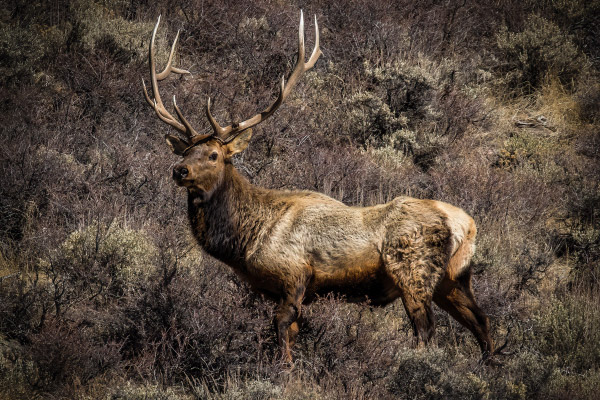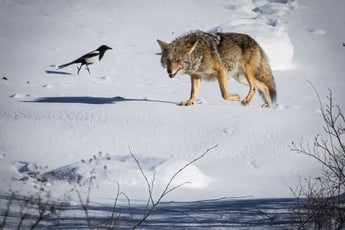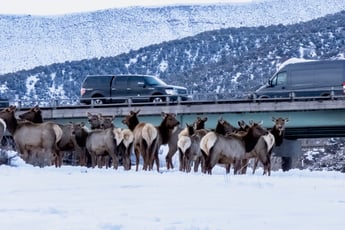Survival for wildlife can be very difficult. Even though plants and animals have special adaptations that improve their chances of survival in specific environments, it is no guarantee. “Survival of the Fittest” is a reality for the natural world, not just a phrase.
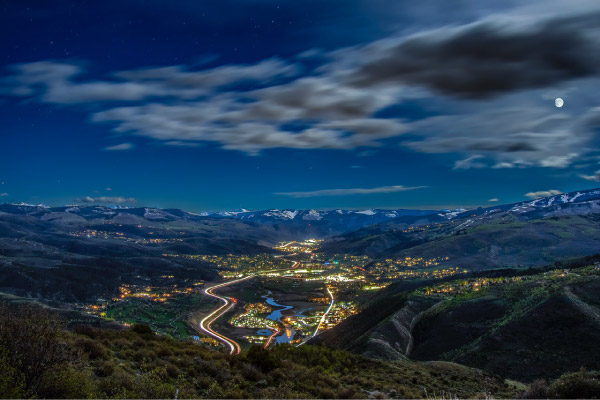
When we really look at our ”Piece of Paradise” we don’t often think of the fact that we have taken over a huge amount
of the area that the native wildlife used to call home.
That phrase has an interesting history. The conventional wisdom is that Charles Darwin coined the phrase. He developed evolutionary theory and the concept of natural selection, but never used the phrase in the first editions of his book “On the Origin of Species.” Herbert Spencer, an English biologist coined the phrase in his book “Principles of Biology” in 1864. Alfred Russel Wallace, a British naturalist suggested to Darwin that he use the phrase "survival of the fittest" as an alternative to "natural selection." Darwin liked the idea and used it in future publications of his book “On the Origin of Species.”
So, what does “Survival of the Fittest” really mean to wildlife? In addition, should “Survival of the Fittest” also include the concept of “Survival of the Luckiest?” In nature there are all kinds of things that wildlife deals with and there are a lot of “right place, right time” that leads to survival that could just as easily be “wrong place, wrong time” and be the demise of some species or individuals.
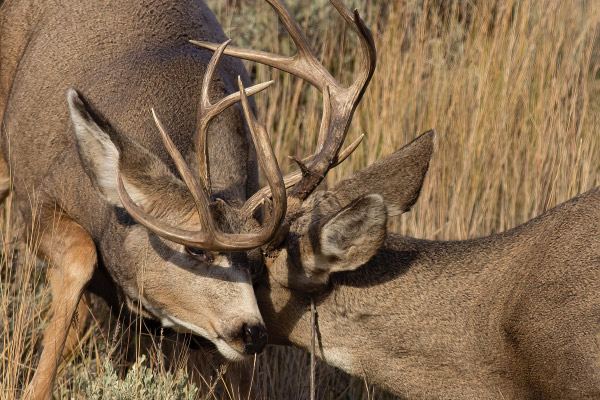
Mule deer and elk battles during the rut can be dangerous. Those antlers can poke out eyes and cause puncture wounds that may become infected.
In Eagle County the single greatest impact on the survival of many species, particularly deer, elk, and bighorn sheep is the loss of habitat. Historically, elk, have used the meadows in the valley for food and shelter. Elk are herbivores and their favorite foods are grasses, forbs, and shrubs. A forb is any broad-leaved herbaceous plant that is not a grass. Forbs have high nutritional value during the growing season. Based on research, grass is the favored food for Elk. Most grassy meadows in the valley are gone.
For deer and bighorn sheep their historical use of the valley has been on the open, south facing hillsides. The favorite foods of mule deer are the leaves, needles, succulent stems, fruits and seeds of trees, shrubs, and forbs. Bighorn sheep browse on grasses, clover, and sedges in the warm months but switch to eating sage, willow, and other woody plants in the winter. That type of forage is significantly different from other ungulates like cattle and elk.
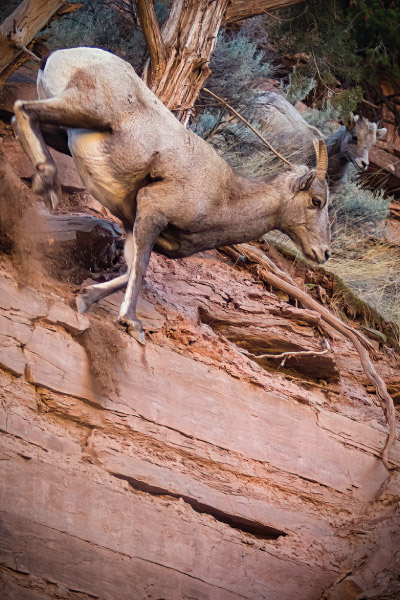
Our local wildlife lives in areas that have dangerous situations. Slips and falls can result in an injury that is life threatening.
The habitat requirements for these animals are the same as our habitat preferences. Building in meadows requires less surface preparation and is less costly in terms of infrastructure construction cost. Building on the hillsides is more costly, but with improvements in technology and hardware, it is still reasonable to build and maintain mountain side property. The problem is that where we choose to build, takes away from the habitat needed by deer, elk, and bighorn sheep, particularly in the stressful winter months.
In addition, our construction of roads, housing, and commercial areas have blocked the ability of animals to follow the migration routes or have removed the grazing areas from use altogether. In addition, construction of fencing on highways prohibits animals from following their historical migration routes. Wildlife overpasses and underpasses can help to alleviate those issues, but they are expensive to build. In this valley there are areas where they would be of no value because the migration routes across the valley have already been blocked by construction.
Animals acquire diseases and injuries that can make survival difficult. This elk is malnourished due to an unknown cause.
Wildlife often gets into conflicts with members of their own species as well as other species, particularly when resources are limited. In the winter, many animals that are normally scattered across wide areas begin to converge on their historical meadows. As that acreage is lost due to development, the amount of space used by wildlife during the rut and for food during the winter decreases. Reproductive success and the ability to maintain nourishment diminishes.
Some people may argue that those animals can move to another location. Where? Other locations may not meet the needs of the animals. In addition, other areas may already be populated by other members of their species, and the addition of these additional animals may produce a situation where the food supply may not meet the demands of this increased population. What happens? Animals die!
In fall and winter, mule deer and other animals find other types of food that meet their needs.
All animals need food, water, and shelter for survival. However, due to climate change the ability to find those things is changing. The growing seasons are shifting and becoming longer. Temperatures are warming and that is causing some plants to begin growing sooner and going to seed sooner. Trees are budding earlier in the season and become more susceptible to late spring freezing. Rivers are warming and making survival for trout more tenuous.
A longer summer means that some insect species like the pine beetles are now producing two to four broods in one summer and that may change the ability of some plants to survive the attacks by increased numbers of insects. Hummingbirds may arrive and find the plants or insects they depend on are already past their prime and are not available as their normal food supply.

Charles Darwin did not coin the phrase “Survival of the Fittest" in 1800’s but began using it later at the suggestion of a colleague
Alfred Russel Wallace, a British naturalist.
Animals like ptarmigan and long-tailed weasels change to their white coats in the late fall and back to summer colors in early spring. However, snow is coming later and melting off earlier. That is not a good thing for an animal that is white and is now living on a brown landscape.
We all know what life is like for us and others when we get ill or as we get older. We have doctors that can help us out and family and friends that can assist us when needed. Wildlife does not have that support.

Bighorn under deep snow in the winter can be difficult for almost all wildlife species. This bighorn ram is pawing through the snow
to reach grasses and forbs it needs for survival.
Natural hazards in the environment can injure or kill wildlife. Falls, stepping into holes, or tripping over limbs can break bones and cause other injuries. Collisions with branches or rocks when trying to escape from a predator may cause injury and result in being captured. Animals that fight during the rut, or mating activity may sustain injuries that become infected or result in an inability to get nourishment or escape predators.
Predator/prey relationships also take a toll. For mule deer, the natural predator/prey relationship with mt lions is a serious threat. Is it detrimental to the mule deer population? Research has shown that mt. lions kill one deer per week on average. The estimations of Colorado’s mt. lion population by the Colorado Parks & Wildlife (CPW) is between 3,800 and 4,400 mountain lions. That means the mt lions kill between 197,600 to 228,800 mule deer each year! That seems like it would be the end of mule deer populations in a very short time. However, the mule deer/mt. lions have had a predator prey relationship going for thousands of years before humans showed up on the land.
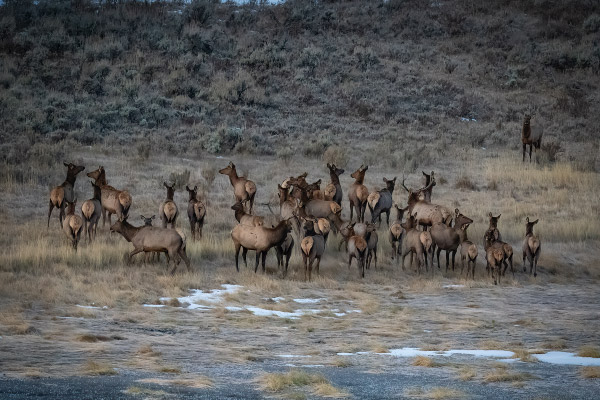
Elk need the valleys to locate their preferred food, grass.
If lions were removed from that relationship, it might allow a deer population to exceed the carrying capacity of an area, which would result in the death of individuals, but from a different cause.
If you spend a great deal of time outside in our environment you will see animals that are in poor health, have been injured, or impacted by some event caused by a person or nature. Should we help them? That can be an emotional struggle.
The Colorado Parks and Wildlife often gets calls from people who want to “help” wildlife that they believe is abandoned or injured. Often, the parent is somewhere nearby foraging and the young are simply waiting for them to return.
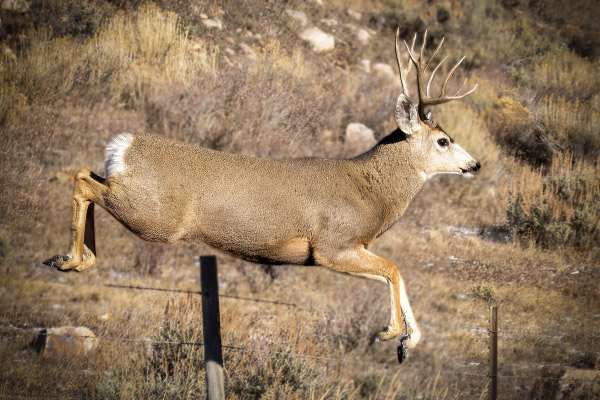
Fencing makes it difficult for wildlife to move around the valley floors. Fencing on the highways is 8” tall and cannot be jumped.
Some want to help wildlife by providing food for them. Some people don’t know that intentionally feeding big game animals is against the law. Feeding can cause animals to congregate in areas where they may become a danger to the local population, spread disease, attract large carnivores, and cause damage to landscaping. In addition, the food provided may be toxic or be of a type that cannot be digested properly by the wildlife. In some situations, animals have died on a full stomach. Feeding wildlife may contribute to their death.
Bird feeding is a different issue. Bird feeding is most helpful during the winter when birds need the most energy, when natural seed sources are depleted. Most research shows that bird feeding is helpful for many species and is not detrimental. Research by scientists at Oregon State University shows that putting out food for small birds in winter does not lead to a dependence on human-provided food.
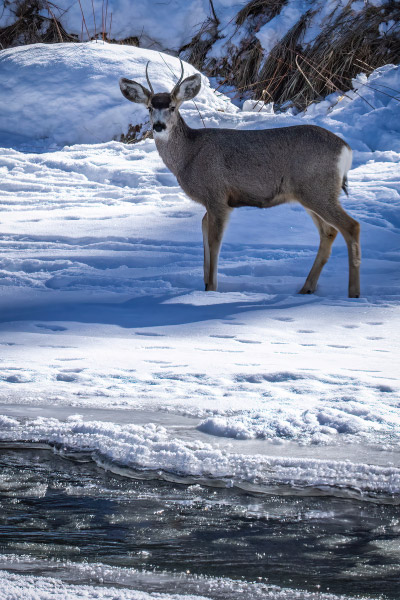
Wandering close to waterways can be dangerous. An animal that falls in has little chance of getting back out.
When in doubt about what to do with wildlife, contact Colorado Parks & Wildlife or a licensed wildlife rehabilitation center.
Nature can be pretty brutal. The best thing to do is to allow our wildlife to remain wild and to do what we can to reduce the human impact on their lives.
Rick Spitzer is the Photographer and writer of the Eagle County Community Wildlife Roundtable.

